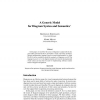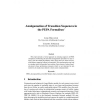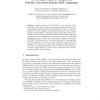92
Voted
ICALP
2000
Springer
15 years 4 months ago
2000
Springer
We study the problem of strong/weak bisimilarity between processes of one-counter automata and finite-state processes. We show that the problem of weak bisimilarity between process...
90
Voted
ICALP
2000
Springer
15 years 4 months ago
2000
Springer
We introduce a generic type system (based on Milner's sort system) for the synchronous polyadic -calculus, allowing us to mechanise the analysis of input/output capabilities o...
111
click to vote
ICALP
2000
Springer
15 years 4 months ago
2000
Springer
We consider the problem of scheduling n independent jobs on m identical machines that operate in parallel. Each job has a controllable processing time. The fact that the jobs have...
ICALP
2000
Springer
15 years 4 months ago
2000
Springer
In this paper, we recall how the syntax of diagrams is captured by the diagram editor generator DIAGEN, and outline a visual, rule-based, and objectoriented programming language b...
91
Voted
ICALP
2000
Springer
15 years 4 months ago
2000
Springer
This report presents a formal approach to reducing sequences in PEPA components. Performing the described amalgamation procedure we may remove, from the underlying Markov chain, t...
102
Voted
ICALP
2000
Springer
15 years 4 months ago
2000
Springer
Message Sequence Charts (MSCs) are an attractive visual formalism widely used to capture system requirements during the early design stages in domains such as telecommunication sof...
83
Voted
ICALP
2000
Springer
15 years 4 months ago
2000
Springer
69
Voted
ICALP
2000
Springer
15 years 4 months ago
2000
Springer
We study contention-resolution protocols for multiple-access channels. We show that every backoff protocol is transient if the arrival rate, , is at least 0.42 and that the capaci...
85
Voted
ICALP
2000
Springer
15 years 4 months ago
2000
Springer
The Unified Modeling Language UML is a rich language so that it seem not feasible to give a single semantics for the complete language in one ste In order to define the semantics,...
107
Voted
ICALP
2000
Springer
15 years 4 months ago
2000
Springer
We explain how recent developments in game semantics can be applied to reasoning about equivalence of terms in a non-trivial fragment of Idealized Algol (IA) by expressing sets of ...



